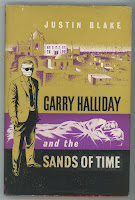The machine, he is told, is incapable of making mistakes. His only chance to escape the drudgery of his assigned position is to volunteer for a much more dangerous scientific job: joining a survey expedition to the post-apocalyptic ruin of Britain...
The basic idea here is a reversal of recognised convention: African explorers and scientists venturing into Britain, measuring native skull size and sizing up local resources such as coal and precious stones. First published in 1954, and republished by the Science Fiction Book Club in 1957 (the edition I've got here), it's playing with anxieties of the time in which it was written.
Colonialism is just part of that anxious mix. The implication is that British, European and American civilisation has been wiped out by nuclear holocaust. As well as fear of the bomb, there is a fear about Britain's reduced status in the world; here, radiation has led to mutation and British people are now just four feet-tall. Their achievements are all but forgotten, too. The Africans have a mangled idea of the history of these people, who they think were at war with the Romans under Napoleon, and whose heroes included "Crom Well" and "Quix Ot" (p. 17).
The cave-dwelling Britons have no knowledge of or interest in history. They are parochial, timid and superstitious, most of them hostile to strangers or any suggestion of change. When one man suggests a better method of dental practice to save people from going mad with toothache, he is forced out of the community.
Grame and the other African explorers are no less short of foibles. They constantly squabble and fight, scientists governed by ego, desire and prejudice as much as by objectivity and logic. As in Margot Bennett's other, later science-fiction novel, The Furious Masters (1968), sexual attraction seems to make people more caustic with each another and sex is bound up with the threat of violence.
My pal Matthew Sweet explored The Long Way Back and the life of its author in his 2015 documentary for Radio 3, Memoirs of a Spacewoman, and wrote a piece about the novel for Unherd in 2020: "Was the British empire a curse?"; the comments under the latter made me think of the response to the dentist. Matthew calls The Long Way Back Bennett's "masterpiece" and likens it to Conrad's Heart of Darkness as a critique of empire.
In addition, it reminded me of other, latter fiction set in post-apocalyptic Britain, such as The Bed-Sitting Room (1969) and Riddley Walker (1980), in which vestiges of the world we know now survive the nuclear holocaust but lose their sense and meaning. Towards the end of the novel, Grame and the surviving members of his team reach the ruin of a once-great city where, in a vast but partially collapsed building, they find the remains of an inscription in stone.
"'There are figures,' Valya said. 'They look like 1993, but I couldn't be certain.' She took out her notebook, and copied faithfully the letter J, followed by nine or ten blanks. They all tried to discover, by fingering, what the letters might have been, but most of them were no more than a roughness on the stone. On the last line, the indentations grew deeper, and Valya wrote carefully, '—e p—a—e —f —od pas— — — a— —und— — sta— — —ng.'" (pp. 184-5)
This, they deduce by filling in the blanks, once read "The place of god's passage and understanding", on which basis they conclude that the whole city was considered holy. It's a joke, I think, playing on a cliche in archaeology, where a site whose purpose is not known is described as having ritual significance.
But also, this is another reversal. The indentations surely once spelled out a relatively well-known phrase from the Bible, in Paul's letter to the Philippians (chapter 4, verse 7):
"The peace of god passeth all understanding."
They've failed to understand that there is no understanding, seeing certainty where there was none.
The novel ends with the surviving members of the expedition flying home - or, as the novel puts it, "flying into uncertainty", unsure of the reception awaiting them and with a looming threat of war. We finish with one of the Britons they've met, watching them go,
"with his heart rising up, while he dreamed of the future when Britain might raise itself, generation by generation, to become a nation that would conquer the earth." (p. 206)
Again, this dream is ironic because we, the reader, can see what conquest has wrought. Yet there does not seem to be much hope that the characters have learned the same lesson.
Speaking of hope, last night BBC Four showed the 1954 production of George Orwell's Nineteen Eighty-Four, adapted by Nigel Kneale and directed by Rudolph Cartier. It begins with an introduction from BBC head of drama Michael Barry:
"To me, the most alarming thing in the play is the fact that it has no hope, and as the mortally ill author George Orwell preciously brought his one script south from Glasgow to London, he couldn't find it within him to give hope to the play."
The Long Way Back came out the same year as that TV adaptation. Margot Bennett was, like Orwell, in Spain during the civil war - there's even some suggestion that they knew one another while in Barcelona. I wonder how much their respective sense of humanity, or what Barry calls man's inhumanity to man, was forged there...
I have more reading to do.























